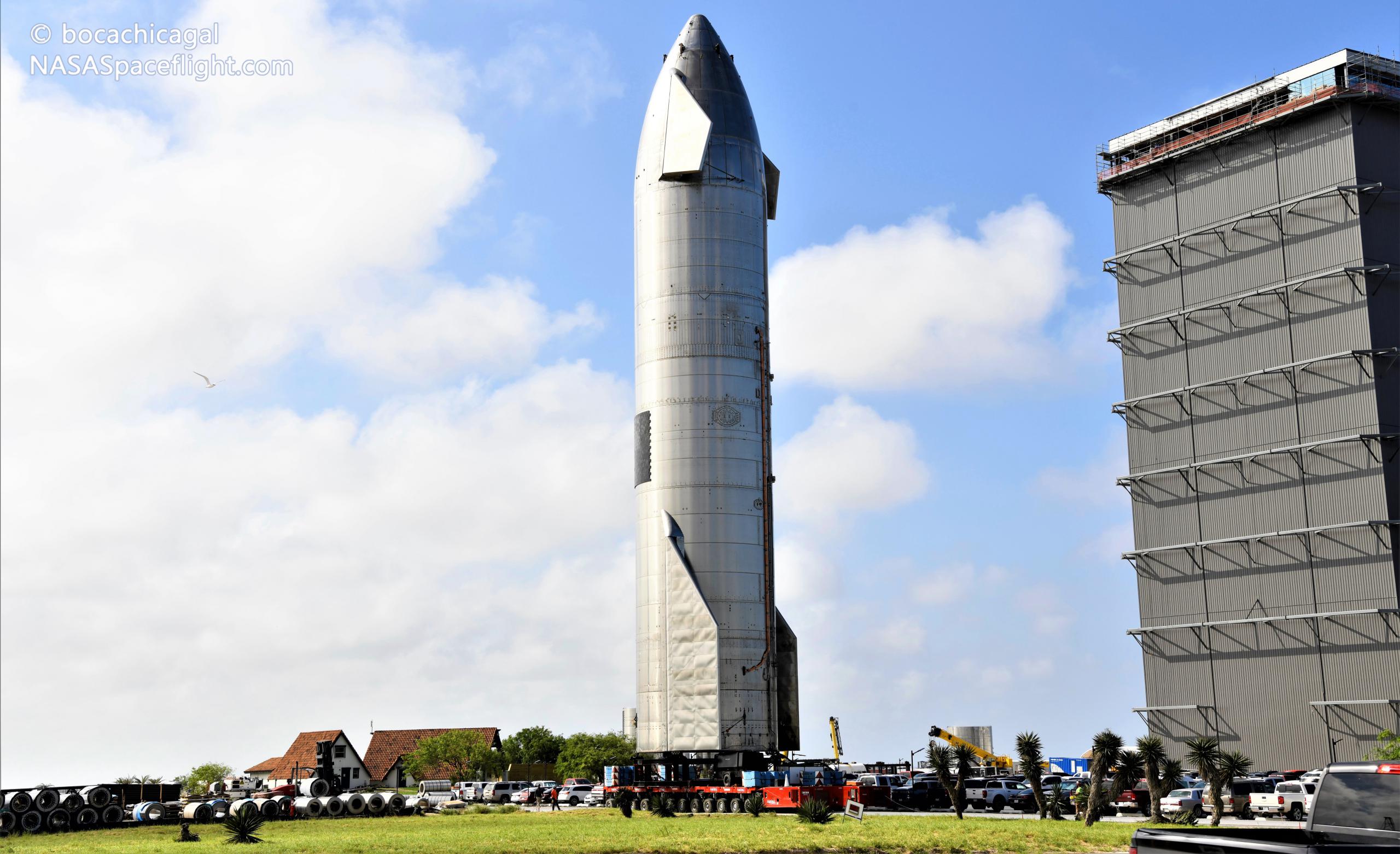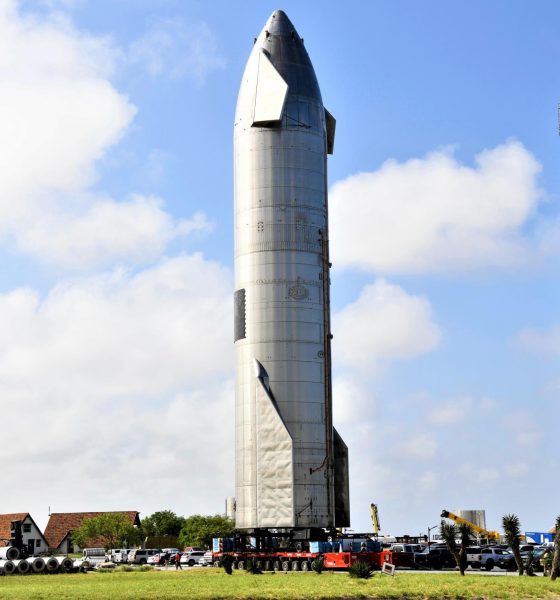

News
SpaceX’s first flight-proven Starship rolled back to factory for likely retirement
While SpaceX has spent the better part of three weeks inspecting the first flight-proven Starship to survive a high-altitude launch and landing, the company appears to have decided to retire the rocket instead of flying it again.
On May 25th, four days after Starship serial number 15 (SN15) was reinstalled on one of SpaceX’s two suborbital launch mounts, a crane was attached to its nose and a transporter staged beside it. One day later, the historic Starship prototype was lifted off of Mount B, installed on that transporter, and rolled away from the launch pad and back towards SpaceX’s Boca Chica, Texas Starship factory.
The day after Starship SN15 was reinstalled on a launch mount, giving SpaceX unrestricted access to its aft, all three of the rocket’s flight-proven Raptor engines – the first of their kind to survive the flight profile intact – were removed. Given the significant value of tearing down and inspecting the first flight-proven high-altitude Raptors, that removal was likely guaranteed regardless of the future of SN15, though it certainly left the Starship at a crossroads.
Having already had its six used landing legs removed, Starship SN15 was left more or less declawed on the launch mount as fans watched with bated breath to see if new legs or engines would be installed. For better or worse, while CEO Elon Musk did indicate that SpaceX “might try to refly SN15 soon” less than two days after its historic landing, it quickly became clear that the company had decided against reuse.
To a degree, especially if SN15’s flight-proven Raptor engines were rendered unusable – as they appear to have been – by exposure to water immediately after touchdown, “reusing” the Starship would be more symbolic than anything. With a thorough inspection, it would be easy enough to determine that the Starship’s structures and mechanical/hydraulic systems would be up for a second launch, but the slow ~10 km (6.2 mi) flight profile ships SN8 through SN11 and SN15 completed was already only relevant for testing Starship’s exotic, unproven method of landing.
In that sense, another fully successful ~10-km launch and landing would only benefit Starship development insofar as it would increase confidence in the landing profile by proving that the first success wasn’t a fluke – however incredibly unlikely that might be. Of note, SpaceX also has not plans to recover the first space-proven Starship, instead (nominally) performing a soft-landing in the Pacific Ocean if the prototype makes it through its inaugural spaceflight without issue.
If that “Orbital Test Flight” is a perfect success, SpaceX will likely have enough confidence – and regulators enough data – to proceed to the first attempt to recover an orbital Starship on land. In the meantime, with orbital launch site buildup now moving at a breakneck pace and tens of millions of dollars of custom pad hardware, giant cranes, and months of work sitting a few hundred feet away from the landing pad, attempting to push the envelope with SN15 likely just isn’t worth the risk.

SN15 is also a historic piece of hardware after its successful landing and there are signs – namely the location SpaceX has moved the rocket to – that the Starship will be put on permanent display beside the factory that built it. There’s a limited possibility that Starship SN16 – all but finished – could be sent to the launch site instead of heading straight to the scrapyard, but any testing would necessarily delay orbital pad construction and any flight activity would likely have to expend SN16 in the ocean rather than risk a land landing.
Ultimately, it’s looking more and more likely that SpaceX would rather go all-in on Starship’s inaugural orbital launch attempt, even if that means little to no ground or flight test availability for a few months.

News
Tesla FSD fleet is nearing 7 billion total miles, including 2.5 billion city miles
As can be seen on Tesla’s official FSD webpage, vehicles equipped with the system have now navigated over 6.99 billion miles.

Tesla’s Full Self-Driving (Supervised) fleet is closing in on almost 7 billion total miles driven, as per data posted by the company on its official FSD webpage.
These figures hint at the massive scale of data fueling Tesla’s rapid FSD improvements, which have been quite notable as of late.
FSD mileage milestones
As can be seen on Tesla’s official FSD webpage, vehicles equipped with the system have now navigated over 6.99 billion miles. Tesla owner and avid FSD tester Whole Mars Catalog also shared a screenshot indicating that from the nearly 7 billion miles traveled by the FSD fleet, more than 2.5 billion miles were driven inside cities.
City miles are particularly valuable for complex urban scenarios like unprotected turns, pedestrian interactions, and traffic lights. This is also the difference-maker for FSD, as only complex solutions, such as Waymo’s self-driving taxis, operate similarly on inner-city streets. And even then, incidents such as the San Francisco blackouts have proven challenging for sensor-rich vehicles like Waymos.
Tesla’s data edge
Tesla has a number of advantages in the autonomous vehicle sector, one of which is the size of its fleet and the number of vehicles training FSD on real-world roads. Tesla’s nearly 7 billion FSD miles then allow the company to roll out updates that make its vehicles behave like they are being driven by experienced drivers, even if they are operating on their own.
So notable are Tesla’s improvements to FSD that NVIDIA Director of Robotics Jim Fan, after experiencing FSD v14, noted that the system is the first AI that passes what he described as a “Physical Turing Test.”
“Despite knowing exactly how robot learning works, I still find it magical watching the steering wheel turn by itself. First it feels surreal, next it becomes routine. Then, like the smartphone, taking it away actively hurts. This is how humanity gets rewired and glued to god-like technologies,” Fan wrote in a post on X.
News
Tesla starts showing how FSD will change lives in Europe
Local officials tested the system on narrow country roads and were impressed by FSD’s smooth, human-like driving, with some calling the service a game-changer for everyday life in areas that are far from urban centers.

Tesla has launched Europe’s first public shuttle service using Full Self-Driving (Supervised) in the rural Eifelkreis Bitburg-Prüm region of Germany, demonstrating how the technology can restore independence and mobility for people who struggle with limited transport options.
Local officials tested the system on narrow country roads and were impressed by FSD’s smooth, human-like driving, with some calling the service a game-changer for everyday life in areas that are far from urban centers.
Officials see real impact on rural residents
Arzfeld Mayor Johannes Kuhl and District Administrator Andreas Kruppert personally tested the Tesla shuttle service. This allowed them to see just how well FSD navigated winding lanes and rural roads confidently. Kruppert said, “Autonomous driving sounds like science fiction to many, but we simply see here that it works totally well in rural regions too.” Kuhl, for his part, also noted that FSD “feels like a very experienced driver.”
The pilot complements the area’s “Citizen Bus” program, which provides on-demand rides for elderly residents who can no longer drive themselves. Tesla Europe shared a video of a demonstration of the service, highlighting how FSD gives people their freedom back, even in places where public transport is not as prevalent.
What the Ministry for Economic Affairs and Transport says
Rhineland-Palatinate’s Minister Daniela Schmitt supported the project, praising the collaboration that made this “first of its kind in Europe” possible. As per the ministry, the rural rollout for the service shows FSD’s potential beyond major cities, and it delivers tangible benefits like grocery runs, doctor visits, and social connections for isolated residents.
“Reliable and flexible mobility is especially vital in rural areas. With the launch of a shuttle service using self-driving vehicles (FSD supervised) by Tesla in the Eifelkreis Bitburg-Prüm, an innovative pilot project is now getting underway that complements local community bus services. It is the first project of its kind in Europe.
“The result is a real gain for rural mobility: greater accessibility, more flexibility and tangible benefits for everyday life. A strong signal for innovation, cooperation and future-oriented mobility beyond urban centers,” the ministry wrote in a LinkedIn post.
News
Tesla China quietly posts Robotaxi-related job listing
Tesla China is currently seeking a Low Voltage Electrical Engineer to work on circuit board design for the company’s autonomous vehicles.

Tesla has posted a new job listing in Shanghai explicitly tied to its Robotaxi program, fueling speculation that the company is preparing to launch its dedicated autonomous ride-hailing service in China.
As noted in the listing, Tesla China is currently seeking a Low Voltage Electrical Engineer to work on circuit board design for the company’s autonomous vehicles.
Robotaxi-specific role
The listing, which was shared on social media platform X by industry watcher @tslaming, suggested that Tesla China is looking to fill the role urgently. The job listing itself specifically mentions that the person hired for the role will be working on the Low Voltage Hardware team, which would design the circuit boards that would serve as the nervous system of the Robotaxi.
Key tasks for the role, as indicated in the job listing, include collaboration with PCB layout, firmware, mechanical, program management, and validation teams, among other responsibilities. The role is based in Shanghai.
China Robotaxi launch
China represents a massive potential market for robotaxis, with its dense urban centers and supportive policies in select cities. Tesla has limited permission to roll out FSD in the country, though despite this, its vehicles have been hailed as among the best in the market when it comes to autonomous features. So far, at least, it appears that China supports Tesla’s FSD and Robotaxi rollout.
This was hinted at in November, when Tesla brought the Cybercab to the 8th China International Import Expo (CIIE) in Shanghai, marking the first time that the autonomous two-seater was brought to the Asia-Pacific region. The vehicle, despite not having a release date in China, received a significant amount of interest among the event’s attendees.








